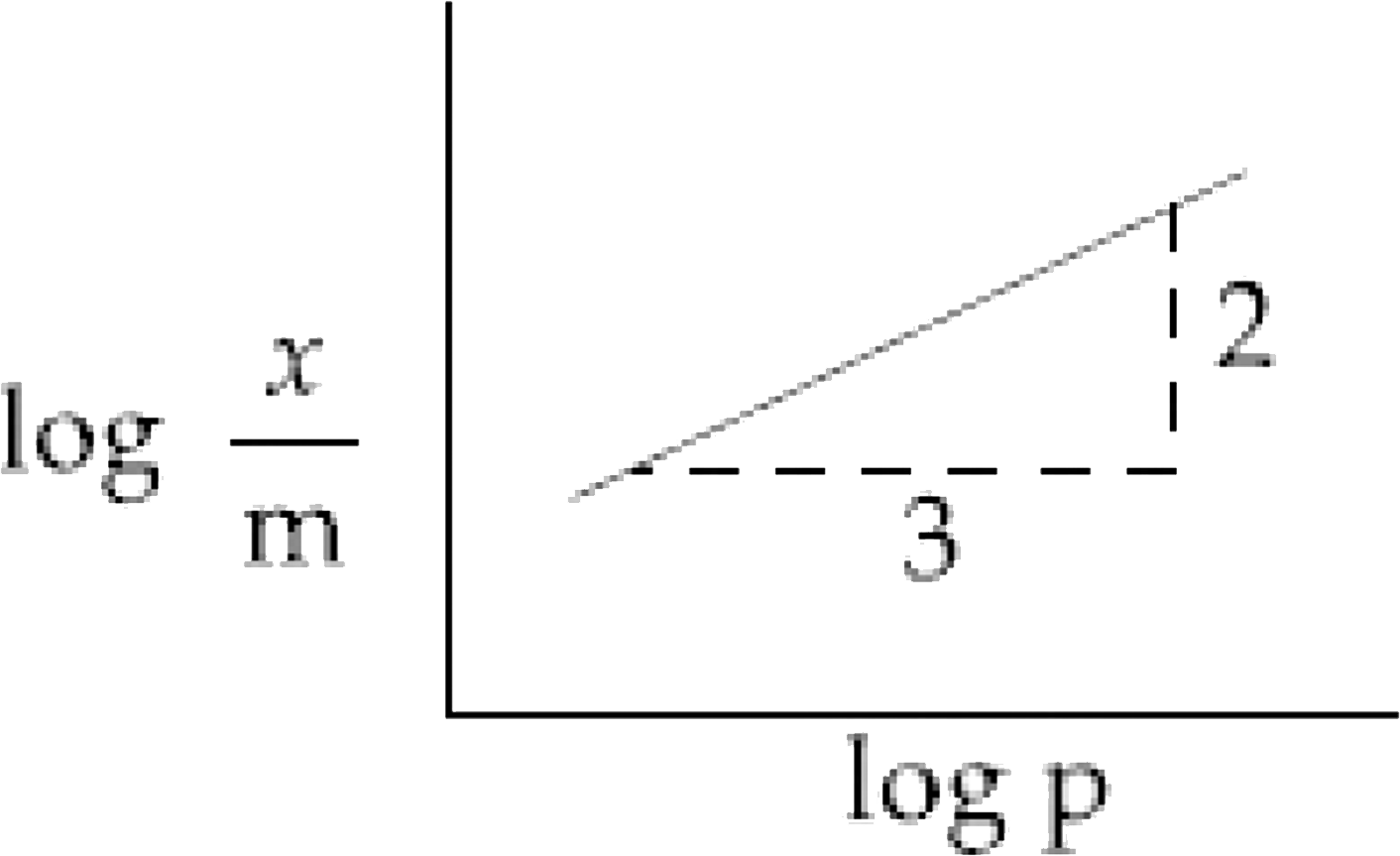For Freundlich adsorption isotherm, xm=kp1/n , the value of n is
1. always greater than one
2. always smaller than one
3. always equal to one
4. greater than one at low temperature and smaller than one at high temperature.
The correct Answer is:A
To determine the value of n in the Freundlich adsorption isotherm equation given by
xm=kp1n
we can analyze the behavior of the adsorption process at different pressures.
1. Understanding the Equation:
The equation xm=kp1n describes the relationship between the extent of adsorption (xm), the pressure of the gas (p), and the constants k and n. Here, x is the amount of gas adsorbed, m is the mass of the adsorbent, and k and n are constants that depend on the nature of the adsorbate and adsorbent.
2. Behavior at Low Pressure:
At low pressures, the extent of adsorption (xm) is directly proportional to the pressure (p). This can be expressed as:
xm∝p
In this case, we can see that when p is low, 1n approaches 1, which implies:
n=1
3. Behavior at High Pressure:
At high pressures, the system reaches saturation pressure, where the amount of gas adsorbed becomes constant regardless of further increases in pressure. Thus, the extent of adsorption becomes independent of pressure:
xm=kp0
This indicates that p1n approaches a constant value, leading to:
1n→0orn→∞
4. Intermediate Pressures:
Between low and high pressures, the value of n varies continuously. The value of n decreases from 1 (at low pressure) to a very high value (approaching infinity) as the pressure increases. Therefore, n can take values greater than 1 but less than infinity.
5. Conclusion:
Based on the analysis, the value of n is always greater than 1. Hence, the correct answer is that n is always greater than 1.
Final Answer:
The value of n is always greater than 1.
The equation xm=kp1n describes the relationship between the extent of adsorption (xm), the pressure of the gas (p), and the constants k and n. Here, x is the amount of gas adsorbed, m is the mass of the adsorbent, and k and n are constants that depend on the nature of the adsorbate and adsorbent.
At low pressures, the extent of adsorption (xm) is directly proportional to the pressure (p). This can be expressed as:
xm∝p
In this case, we can see that when p is low, 1n approaches 1, which implies:
n=1
At high pressures, the system reaches saturation pressure, where the amount of gas adsorbed becomes constant regardless of further increases in pressure. Thus, the extent of adsorption becomes independent of pressure:
xm=kp0
This indicates that p1n approaches a constant value, leading to:
1n→0orn→∞
Between low and high pressures, the value of n varies continuously. The value of n decreases from 1 (at low pressure) to a very high value (approaching infinity) as the pressure increases. Therefore, n can take values greater than 1 but less than infinity.
Based on the analysis, the value of n is always greater than 1. Hence, the correct answer is that n is always greater than 1.
The value of n is always greater than 1.
Topper's Solved these Questions
- BOOK - NCERT FINGERTPS ENGLISHCHAPTER - SURFACE CHEMISTRYEXERCISE - HOTS7videos
SURFACE CHEMISTRY
- BOOK - NCERT FINGERTPS ENGLISHCHAPTER - SURFACE CHEMISTRYEXERCISE - NCERT EXEMPLAR PROBLEMS25videos
SURFACE CHEMISTRY
- BOOK - NCERT FINGERTPS ENGLISHCHAPTER - SOLUTIONS EXERCISE - Assertion And Reason15videos
SOLUTIONS
- BOOK - NCERT FINGERTPS ENGLISHCHAPTER - THE D- AND F- BLOCK ELEMENTS EXERCISE - Assertion And Reason15videos
THE D- AND F- BLOCK ELEMENTS
Similar Questions
Freundlich adsorption isotherm is
View SolutionWhat is Freundlich adsorption isotherm ?
View SolutionHow can the Freundlich adsorption isotherm be represented when the value of n is less than one?
View SolutionThe equation for Freundlich adsorption isotherm is
View SolutionIn the Freundich adsorption isotherm, the value of (1n) is between 0 and ………… .
View SolutionIn freundlich adsorption isotherm, the value of 1/n is
View SolutionAdsorption of gas follows Freundlich adsorption isotherm. If x is the mass of the gas adsorbed on mass m of the adsrobent , the correct plot of xm versus p is :
View SolutionAccording to Freundlich adsorption isotherm, which of the following is correct?
View SolutionAdsorption of gas follows Freundlich adsorption isotherm. x is the mass of the gas adsorbed on mass m of the adsorbent. The plot of logxm versus log p is shown in the given graph.
xm is proportional to:
 View Solution
View SolutionAdsorptionof a gas follows Freundlich adsorption isotherm. x is the mass of the gas adsorbed on mass m of the adsorbent.
The plot of logxm versus log p is shown in the given graph xm is proportional to :
 View Solution
View Solution

